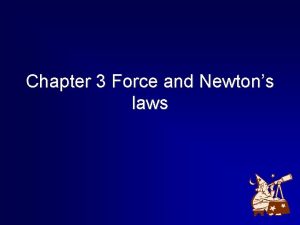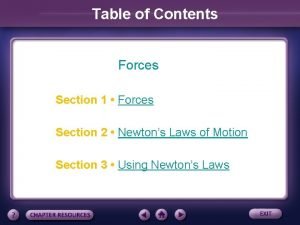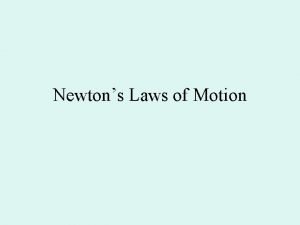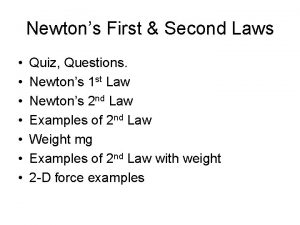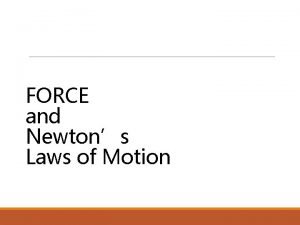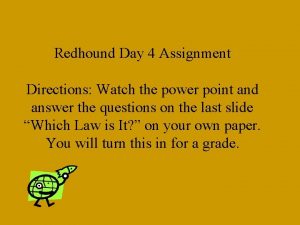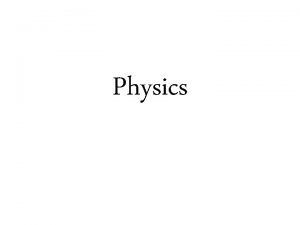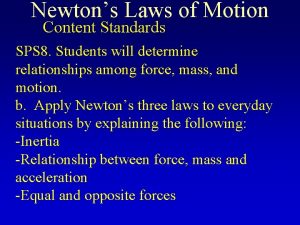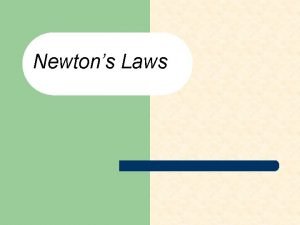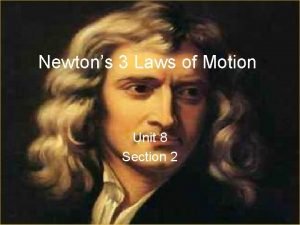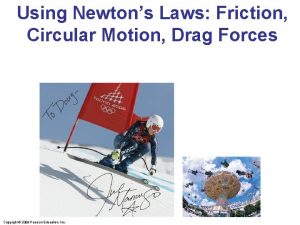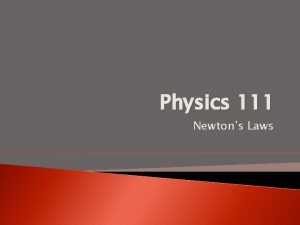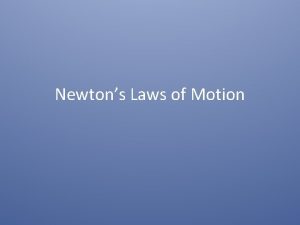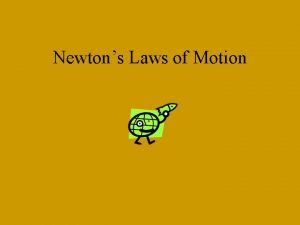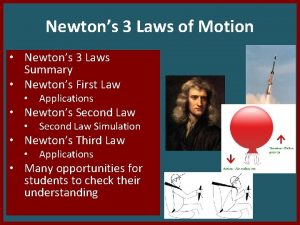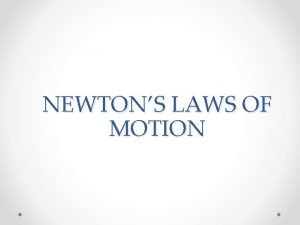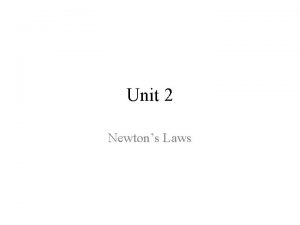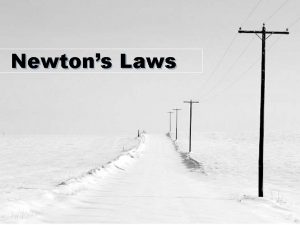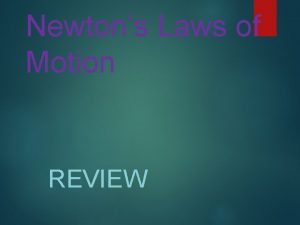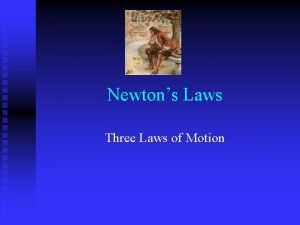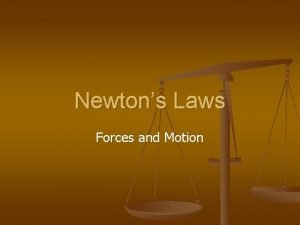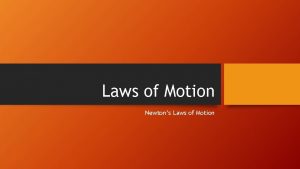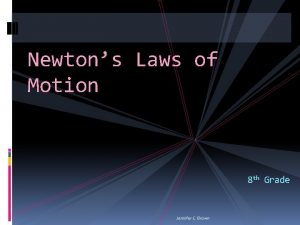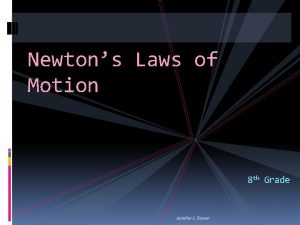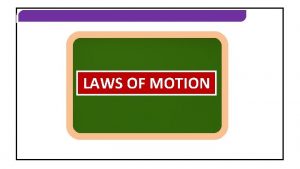Newtons Laws of Motion 8 th Grade Jennifer























- Slides: 23

Newton’s Laws of Motion 8 th Grade Jennifer C. Brown

5. 3 - Forces and Equilibrium ~Background info~ The sum of all the forces acting on an object is called the “net force” (or total force). Jennifer C. Brown

5. 3 - Forces and Equilibrium To figure out if or how an object will move, we look at ALL of the forces acting on it. Jennifer C. Brown

5. 3 - Forces and Equilibrium When several forces act on the same object: 1. The net force is zero Or 2. The net force is NOT zero. Jennifer C. Brown

5. 3 - Forces and Equilibrium When the forces are balanced, the net force is zero. When the net force on an object is zero, we say the object is in equilibrium. Jennifer C. Brown

5. 3 - Forces and Equilibrium What is a normal force? A normal force is created whenever an object is in contact with a surface. The normal force has equal strength to the force pressing the object into the surface, which is often the object’s weight. Jennifer C. Brown

Newton’s 1 st Law of Motion: Law of Inertia Newton’s first law says that objects continue the motion they already have unless they are acted on by a net force. “An object at rest will stay at rest and an object in motion will stay in motion UNLESS there is a net force to act on it. ” http: //teachertube. com/view. Video. php? title=Newtons_Law_1_on_Inertia&video_id=21642 Jennifer C. Brown

Newton’s 1 st Law of Motion: Law of Inertia is the property of an object that resists changes in motion. Objects with more mass have more inertia and are more resistant to changes in their motion. Which ball has more inertia? Jennifer C. Brown

Newton’s 2 nd Law of Motion: Force = mass x acceleration According to Newton’s second law, the amount of acceleration depends on both the force and the mass. There are three main ideas related to Newton’s Second Law: F=mxa 1. Acceleration is the result of unbalanced forces. 2. A larger force makes a larger acceleration. 3. Acceleration is inversely proportional to mass. Jennifer C. Brown

Newton’s 2 nd Law of Motion: Force = mass x acceleration The stronger the force on an object, the greater its acceleration. Jennifer C. Brown

Newton’s 2 nd Law of Motion: Force = mass x acceleration The greater the mass, the smaller the acceleration for a given force. Jennifer C. Brown

Newton’s 2 nd Law of Motion: Force = mass x acceleration Newton’s Third Law (action-reaction) applies when a force is placed on any object. “For every action, there is an equal and opposite reaction. ” Jennifer C. Brown

Newton’s 3 rd Law of Motion: action - reaction One force acts on the ball, and the other force acts on the hand. Jennifer C. Brown

Newton’s 3 rd Law of Motion: action - reaction You pushing ground The action force is____________, and the reaction force is the Ground pushing back on you _______________. Jennifer C. Brown

Newton’s 3 rd Law of Motion: action - reaction Newton’s third law tells us that any time two objects hit each other, they exert equal and opposite forces on each other. The effect of the force is not always the same. Jennifer C. Brown

Newton’s 3 rd Law of Motion: action - reaction Momentum (P) is the mass of an object times its velocity. Jennifer C. Brown

Newton’s 3 rd Law of Motion: action - reaction The law of conservation of momentum states that as long as the interacting objects are not influenced by outside forces (like friction) the total amount of momentum is constant or does not change. Newton’s Cradle Jennifer C. Brown

Newton’s 3 Laws Rap http: //www. myxer. com/video/id/1979829/Sha yi. Ly/Laws-Of-Motion-Rap/ Jennifer C. Brown

November 21 -22, 2011 Your Name Objective: We will review Forces and Newton’s 3 laws of motion. Homework: Worksheet on applying Newton’s 3 Laws & Notebook Test Next Week (after Break) Do Now: 1) What is Newton’s First Law of Motion? 2) What is Newton’s Second Law of Motion? 3) What is Newton’s Third Law of Motion? Jennifer C. Brown

November 23, 2011 Your Name Objective: Further review of Forces and Newton’s 3 laws of motion. Homework: Notebook Test Next Tuesday (after Break)!! Do Now: 1) What is the relationship between the mass & the inertia of an object? 2) If a person pushes on a box at F= 100 N and another person pushes on the same box in the opposite direction at F = 90 N, the resulting force is equal to what? Jennifer C. Brown

Question(s): Two chains are used to support a small boat weighing 1, 500 newtons. - One chain has a tension of 600 newtons. - What is the force exerted by the other chain? Jennifer C. Brown

Question(s): Is this object in equilibrium? Yes Jennifer C. Brown

Question(s): A car has a mass of 1, 000 kilograms. If a net force of 2, 000 N is exerted on the car, what is its acceleration? Jennifer C. Brown
 Newtons laws od motion
Newtons laws od motion Newtons second lw
Newtons second lw Newton three law of motion
Newton three law of motion Newtons laws of motion
Newtons laws of motion Facts about newtons first law
Facts about newtons first law Universal gravity constant
Universal gravity constant What are newton's 3 laws
What are newton's 3 laws Newtons laws of gravity
Newtons laws of gravity Section 3 using newton's laws
Section 3 using newton's laws Section 1 forces
Section 1 forces Abcd8n
Abcd8n Newtons 1 st law
Newtons 1 st law Newton's first and second law quiz
Newton's first and second law quiz Newtons laws definitions
Newtons laws definitions Newton three law
Newton three law Newton laws
Newton laws Law of newton
Law of newton Newton (unit)
Newton (unit) Second law of motion examples
Second law of motion examples 3 law of newton
3 law of newton Newton's laws of motion
Newton's laws of motion Law of friction
Law of friction An african elephant can reach heights of 13 feet
An african elephant can reach heights of 13 feet Newtons 3 rd law of motion
Newtons 3 rd law of motion








